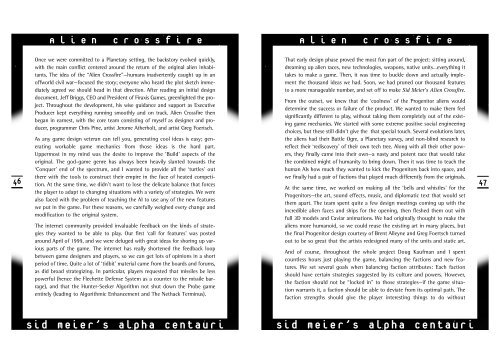Alien Crossfire Manual • Linux
Alien Crossfire Manual • Linux
Alien Crossfire Manual • Linux
You also want an ePaper? Increase the reach of your titles
YUMPU automatically turns print PDFs into web optimized ePapers that Google loves.
46<br />
<strong>Alien</strong> <strong>Crossfire</strong><br />
Once we were committed to a Planetary setting, the backstory evolved quickly,<br />
with the main conflict centered around the return of the original alien inhabitants.<br />
The idea of the “<strong>Alien</strong> <strong>Crossfire</strong>”—humans inadvertently caught up in an<br />
offworld civil war—focused the story; everyone who heard the plot sketch immediately<br />
agreed we should head in that direction. After reading an initial design<br />
document, Jeff Briggs, CEO and President of Firaxis Games, greenlighted the project.<br />
Throughout the development, his wise guidance and support as Executive<br />
Producer kept everything running smoothly and on track. <strong>Alien</strong> <strong>Crossfire</strong> then<br />
began in earnest, with the core team consisting of myself as designer and producer,<br />
programmer Chris Pine, artist Jerome Atherholt, and artist Greg Foertsch.<br />
As any game design veteran can tell you, generating cool ideas is easy; generating<br />
workable game mechanics from those ideas is the hard part.<br />
Uppermost in my mind was the desire to improve the ‘Build’ aspects of the<br />
original. The god-game genre has always been heavily slanted towards the<br />
‘Conquer’ end of the spectrum, and I wanted to provide all the ‘turtles’ out<br />
there with the tools to construct their empire in the face of heated competition.<br />
At the same time, we didn’t want to lose the delicate balance that forces<br />
the player to adapt to changing situations with a variety of strategies. We were<br />
also faced with the problem of teaching the AI to use any of the new features<br />
we put in the game. For these reasons, we carefully weighed every change and<br />
modification to the original system.<br />
The internet community provided invaluable feedback on the kinds of strategies<br />
they wanted to be able to play. Our first ‘call for features’ was posted<br />
around April of 1999, and we were deluged with great ideas for shoring up various<br />
parts of the game. The internet has really shortened the feedback loop<br />
between game designers and players, so we can get lots of opinions in a short<br />
period of time. Quite a lot of ‘tidbit’ material came from the boards and forums,<br />
as did broad strategizing. In particular, players requested that missiles be less<br />
powerful (hence the Flechette Defense System as a counter to the missile barrage),<br />
and that the Hunter-Seeker Algorithm not shut down the Probe game<br />
entirely (leading to Algorithmic Enhancement and The Nethack Terminus).<br />
Sid meier’s alpha centauri<br />
<strong>Alien</strong> <strong>Crossfire</strong><br />
That early design phase proved the most fun part of the project: sitting around,<br />
dreaming up alien races, new technologies, weapons, native units…everything it<br />
takes to make a game. Then, it was time to buckle down and actually implement<br />
the thousand ideas we had. Soon, we had pruned our thousand features<br />
to a more manageable number, and set off to make Sid Meier’s <strong>Alien</strong> <strong>Crossfire</strong>.<br />
From the outset, we knew that the ‘coolness’ of the Progenitor aliens would<br />
determine the success or failure of the product. We wanted to make them feel<br />
significantly different to play, without taking them completely out of the existing<br />
game mechanics. We started with some extreme positive social engineering<br />
choices, but these still didn’t give the that special touch. Several evolutions later,<br />
the aliens had their Battle Ogre, a Planetary survey, and non-blind research to<br />
reflect their ‘rediscovery’ of their own tech tree. Along with all their other powers,<br />
they finally came into their own—a nasty and potent race that would take<br />
the combined might of humanity to bring down. Then it was time to teach the<br />
human AIs how much they wanted to kick the Progenitors back into space, and<br />
we finally had a pair of factions that played much differently from the originals.<br />
At the same time, we worked on making all the ‘bells and whistles’ for the<br />
Progenitors—the art, sound effects, music, and diplomatic text that would set<br />
them apart. The team spent quite a few design meetings coming up with the<br />
incredible alien faces and ships for the opening, then fleshed them out with<br />
full 3D models and Caviar animations. We had originally thought to make the<br />
aliens more humanoid, so we could reuse the existing art in many places, but<br />
the final Progenitor design courtesy of Brent Alleyne and Greg Foertsch turned<br />
out to be so great that the artists redesigned many of the units and static art.<br />
And of course, throughout the whole project Doug Kaufman and I spent<br />
countless hours just playing the game, balancing the factions and new features.<br />
We set several goals when balancing faction attributes: Each faction<br />
should have certain strategies suggested by its culture and powers. However,<br />
the faction should not be “locked in” to those strategies—if the game situation<br />
warrants it, a faction should be able to deviate from its optimal path. The<br />
faction strengths should give the player interesting things to do without<br />
Sid meier’s alpha centauri<br />
47


